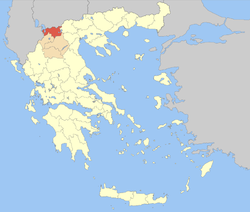Florina Prefecture
|
Florina Περιφερειακή ενότητα Φλώρινας |
|
|---|---|
| Regional unit | |

Municipalities of Florina
|
|
 Florina within Greece |
|
| Coordinates: 40°45′N 21°25′E / 40.750°N 21.417°ECoordinates: 40°45′N 21°25′E / 40.750°N 21.417°E | |
| Country | Greece |
| Region | West Macedonia |
| Capital | Florina |
| Area | |
| • Total | 1,924 km2 (743 sq mi) |
| Population (2011) | |
| • Total | 51,414 |
| • Density | 27/km2 (69/sq mi) |
| Postal codes | 53x xx |
| Area codes | 238x0, 246x0 |
| ISO 3166 code | GR-63 |
| Car plates | ΡΑ |
| Website | www |
Florina (Greek: Περιφερειακή ενότητα Φλώρινας) is one of the regional units of Greece. It is part of the region of West Macedonia. Its capital is the town of Florina.
Florina borders the regional units of Pella to the east, Kozani to the south and Kastoriá to the southwest. At the Greek international borders, it is adjacent to Albania (Korçë County) to the west, the Republic of Macedonia (Bitola and Resen municipalities) to the north and Lake Prespa to the northwest, where the two borders cross each other. Lake Vegoritida is situated in the east.
Mountains in the regional unit include Verno (2,128 m or 6,982 ft), Varnous (2,117 m or 6,946 ft) and Voras (2,524 m or 8,281 ft).
The regional unit Florina is subdivided into 3 municipalities. These are (number as in the map in the infobox):
Florina was created as a prefecture (Greek: Νομός Φλώρινας) in 1915. As a part of the 2011 Kallikratis government reform, the regional unit Florina was created out of the former prefecture Florina. The prefecture had the same territory as the present regional unit. At the same time, the municipalities were reorganised, according to the table below.
According to the 2011 census, the population of Florina regional unit was 51,414 people. The local Greek population includes a linguistic minority of bilingual Slavophones, who in the early 1990s formed about 64% of the rural population and about 16% of the prefecture's total population. There are also around 1,200 Slavophones—approximately 2% of the local population—who profess an ethnic Macedonian identity. There also exist smaller communities of Aromanians and Arvanites, which today mostly have an ethnic Greek identity.
...
Wikipedia
